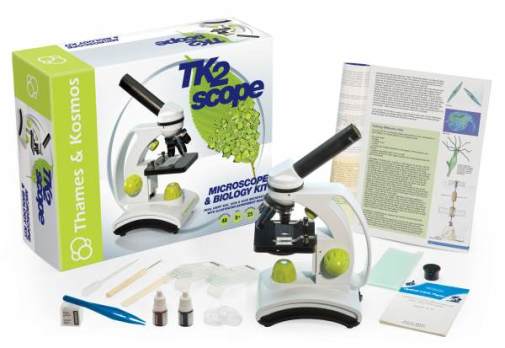We use cookies to make your experience better. To comply with the new e-Privacy directive, we need to ask for your consent to set the cookies. Learn more.
TK2 Scope - Microscope & Biology Kit
Microscope activity books are great if you already have everything you need to start making your own slides, but what if you don't? That's why I like this kit. The experiment manual is solid enough to stand on its own - a rarity in most science kits today - and the kit includes everything you need to begin using the microscope, exploring prepared slides, and preparing and making your own slides. The full-color 48-page manual begins by explaining microscope use and care, as well as how to safely make thin slices from specimens using a scalpel or razor blade. Then young scientists are ready to start observing! The following sections focus on viewing cells of different types, including cheek cells, onion skin, onion cells affected by salt, egeria/elodea, various fruits and vegetables, starch from foodstuffs, hydra, pollen grains, salt and sugar crystals, insect wings, insect specimens, mushrooms, root hairs, watermelon water ducts, blades of grass, leaves, hair, nettle hairs, and feathers. Each section provides informational text about the subject viewed, detailed instructions on how to make and mount the specimen, tips on specimen-making techniques, and photos of photographed specimens under the microscope. Since the student will probably not be very proficient at preparing their own slides, several prepared slides are included as examples, and the more difficult-to-make specimens are saved for later in the book. The photos of example specimens are also helpful for beginners. Unlike many microscope kits, this one actually has a fairly decent microscope. It is constructed of metal and plastic microscope and has pretty good focusing ability. Features include: a monocular 10X eyepiece, 4X, 10X and 40X glass objective lenses (for 40X, 100X and 400X total magnification). The microscope includes two bright LED lights, one above and one below the stage. This kit would be a great choice for a microscope study, along with a science curriculum, or just for the interested student, especially if you are not planning on investing in a good-quality microscope in the future. Kit includes the experiment manual, microscope, blank slides, prepared slides, coverslips, tweezers, a dissection needle, a scalpel, a pipette, Petri dish with lid, stain, lens paper, blank labels for slides, and a dust cover for the microscope. Microscope requires 3 AA batteries (not included). - Jess
If you're not sure which microscope best fits your needs, check out our Microscope Comparison Sheet for a side-by-side comparison of all microscope models we offer.
TK2 Scope from Rainbow Resource on Vimeo.
Review and compare microscopes sold at Rainbow Resource Center with our helpful Microscope Comparison Charts for: Grades K-8 and for Grades 6-12. Each microscope on the charts has an item number that links back to our website for a detailed description.
| Product Format: | Microscope |
|---|---|
| Brand: | Thames and Kosmos |
| Grades: | 3-AD |
| EAN/UPC: | 857853001704 |
| Length in Inches: | 16.5 |
| Width in Inches: | 5.1 |
| Height in Inches: | 13 |
| Weight in Pounds: | 4 |

